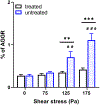Investigation of the role of von Willebrand factor in shear-induced platelet activation and functional alteration under high non-physiological shear stress
- PMID: 38112069
- PMCID: PMC11023789
- DOI: 10.1111/aor.14698
Investigation of the role of von Willebrand factor in shear-induced platelet activation and functional alteration under high non-physiological shear stress
Abstract
Background: von Willebrand factor (vWF) plays a crucial role in physiological hemostasis through platelet and subendothelial collagen adhesion. However, its role in shear-induced platelet activation and functional alteration under non-physiological conditions common to blood-contacting medical devices (BCMDs) is not well investigated.
Methods: Fresh healthy human blood was treated with an anti-vWF antibody to block vWF-GPIbα interaction. Untreated blood was used as a control. They were exposed to three levels of non-physiological shear stress (NPSS) (75, 125, and 175 Pa) through a shearing device with an exposure time of 0.5 s to mimic typical shear conditions in BCMDs. Flow cytometric assays were used to measure the expression levels of PAC-1 and P-Selectin and platelet aggregates for platelet activation and the expression levels of GPIbα, GPIIb/IIIa, and GPVI for receptor shedding. Collagen/ristocetin-induced platelet aggregation capacity was characterized by aggregometry.
Results: The levels of platelet activation and aggregates increased with increasing NPSS in the untreated blood. More receptors were lost with increasing NPSS, resulting in a decreased capacity of collagen/ristocetin-induced platelet aggregation. In contrast, the increase in platelet activation and aggregates after exposure to NPSS, even at the highest level of NPSS, was significantly lower in treated blood. Nevertheless, there was no notable difference in receptor shedding, especially for GPIIb/IIIa and GPVI, between the two blood groups at the same level of NPSS. The block of vWF exacerbated the decreased capacity of collagen/ristocetin-induced platelet aggregation.
Conclusions: High NPSS activates platelets mainly by enhancing the vWF-GPIbα interaction. Platelet activation and receptor shedding induced by high NPSS likely occur through different pathways.
Keywords: blood‐contacting medical devices; non‐physiological shear stress; platelet activation; platelet dysfunction; von Willebrand factor (vWF).
© 2023 The Authors. Artificial Organs published by International Center for Artificial Organ and Transplantation (ICAOT) and Wiley Periodicals LLC.
Figures








References
-
- Mazzeffi M, Greenwood J, Tanaka K, Menaker J, Rector R, Herr D, et al. Bleeding, Transfusion, and Mortality on Extracorporeal Life Support: ECLS Working Group on Thrombosis and Hemostasis. In: Annals of Thoracic Surgery. Elsevier; USA; 2016. p. 682–9. - PubMed
-
- Shah P, Tantry US, Bliden KP, Gurbel PA. Bleeding and thrombosis associated with ventricular assist device therapy. Journal of Heart and Lung Transplantation. 2017;36:1164–73. - PubMed
-
- Starling RC, Naka Y, Boyle AJ, Gonzalez-Stawinski G, John R, Jorde U, et al. Results of the post-U.S. food and drug administration-approval study with a continuous flow left ventricular assist device as a bridge to heart transplantation: A prospective study using the INTERMACS (Interagency Registry for Mechanically Assisted Circulatory Support). J Am Coll Cardiol. 2011;57:1890–8. - PubMed
-
- Gupta P, McDonald R, Chipman CW, Stroud M, Gossett JM, Imamura M, et al. 20-year experience of prolonged extracorporeal membrane oxygenation in critically III children with cardiac or pulmonary failure. Annals of Thoracic Surgery. 2012;93:1584–90. - PubMed
MeSH terms
Substances
Grants and funding
LinkOut - more resources
Full Text Sources
Miscellaneous

